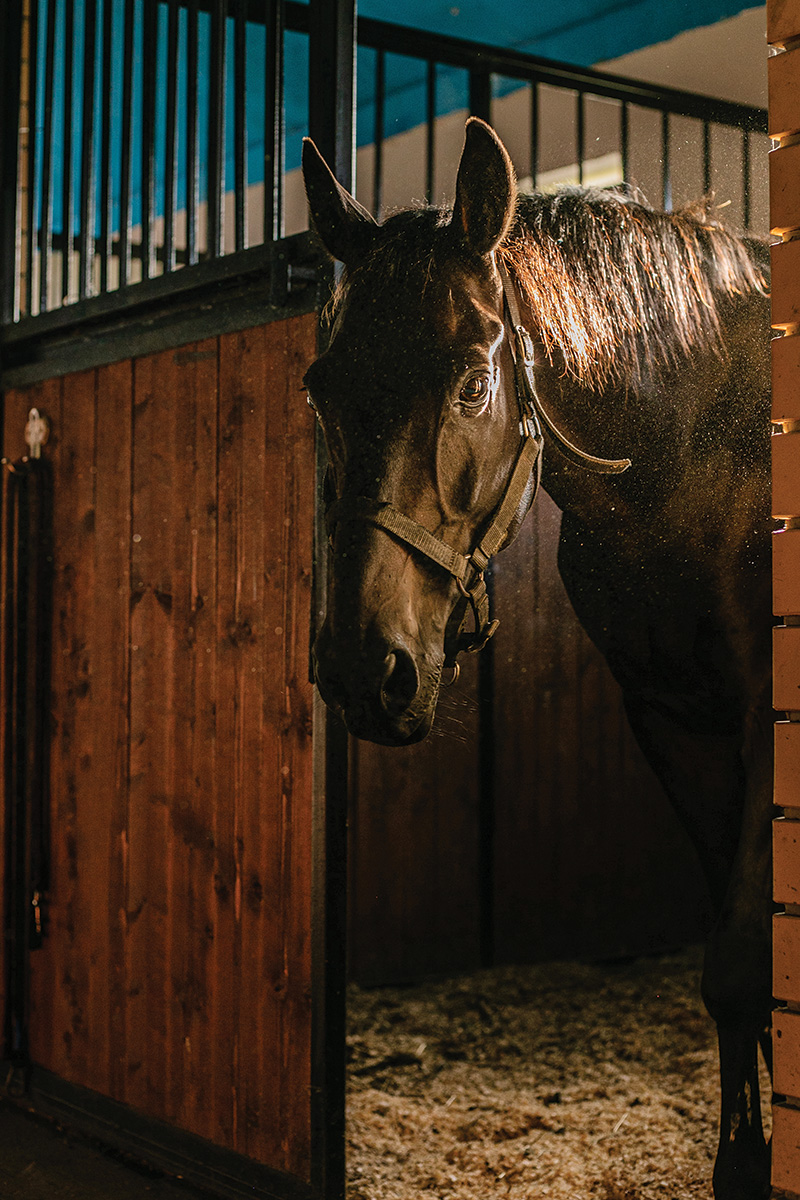“Well, that’s right in the joint,” I said to no one in particular, and sighed in frustration as I pulled my sterilized instrument free from the wound on the big mare’s hind leg. My assistant, Kelly, looked at me in dismay from her position at Dottie’s head. The owners were not present, as they’d had an urgent dinner party that they needed to attend, so it was just the three of us.

Joint Venture
The longer these types of wounds simmered, the graver the prognosis. My assistant checked the mare’s temperature, and it sat at an unhappy 103.9 degrees Fahrenheit. The mare held the leg up and trembled as I prepared a solution to clean and flush the wound. I prayed that it would help, but I knew better. Still, I had to try.
One of the problems with puncture wounds over joints is that the different layers of tissues around them move as the joint flexes and extends. Unless the layers are lined up in the position that the joint was in when the injury happened, they overlap irregularly, making it difficult to get a thorough flush. I tried anyway, but hissed in annoyance when the fluid just shot straight back at me, spattering my coveralls with bloody liquid.
“This is a waste of time,” I grumbled. “I mean, these people leave this poor horse with this injury for almost a week! What am I supposed to do here? And they’re at some dinner party instead of being here with their horse.”
I don’t know if all veterinarians routinely yell at the ceiling, but I was a routine offender. Kelly always took it in stride, but I’m sure she did some eye rolling when I wasn’t looking.
No Complaint Number
She murmured generic responses as I continued to fuss. I’d mastered the art of complaining and working at the same time, so I scrubbed and flushed as much of the joint wound as I could, packed it with manuka honey and placed a sturdy bandage over the hock.
Soon I was injecting strong antibiotics and pain medications, and had administered a tetanus vaccination. Dottie was stoic for the shots, but as soon as I’d capped my needles and was tucking the syringes into the pocket of my coveralls, she pinned her ears and hopped her back end at me.
I scratched her neck and spoke to her softly. “I don’t blame you one bit. This just sucks all around. But the medicine will help you feel better, OK?”
Kelly was cleaning up.
“She yells at the ceiling and talks to horses,” she said brightly to the bucket she was scrubbing. “What do you think of that, little bucket?”
I chuckled and continued capping needles and tossing them into my sharps container. I knew I had a filter problem. Basically, whatever was in my head tended to fly right out of my mouth, and I was also prone to enthusiastically acting out every single emotion that I was feeling in that moment. I’d frequently knock over and spill things, and Kelly used to joke that I needed two assistants: one to clean up the spills, and one to find everything that I would lose throughout the day.
The horse was tentatively bearing weight on the leg, but my stomach churned as Kelly and I climbed into the truck and headed to our next call. These injuries were the worst. It was time to call the owners and prepare them for the next week of their lives: a long drive to the university, a costly surgery and hospitalization, and a guarded prognosis. And I knew they’d try to argue with me and negotiate and debate things and not take the situation seriously, then they’d get angry with me as though it were somehow my fault.
Blame Game
That was exactly what happened. When the husband couldn’t talk me out of the fact that his horse had a life-threatening injury, the wife came on the phone and suggested penicillin shots because she’d read about them on Google, and her trainer was recommending a special wound spray—had I heard of it? Kelly was fidgeting and sighing loudly next to me. I offered her the phone and she snatched it.
“Hi, I’m sorry, but Dr. Diehl is about to step into another appointment. This is Kelly, can I help answer any questions about Dottie? No, the wound is in the joint, so topical treatments aren’t going to help. Yes, we’ve heard of penicillin but unfortunately that’s not the right antibiotic for a mixed bacterial infection in a joint. No, Dr. Diehl isn’t getting a commission from the university for the referral.”
Kelly pushed the end-call button as hard as she could and slammed the phone onto the truck seat. “Fricking people! What is wrong with them? It’s not like we invent these things just to make their lives as difficult as possible.”
“She yells at dashboards and throws cell phones,” I said brightly to my steering wheel. “Isn’t that something!”
Kelly glared at me, panting, then shook her head and laughed.
“Why do I let these people get to me?”
I shrugged. “Because you’re not a bucket or a steering wheel. Some things are beyond our help, and it sucks. Now just punch something and let’s go pull some Coggins and write a lot of health certificates for a thrilling end to the day.”
Kelly gave the seat next to her a hard thump, then turned up the radio, flounced back in her seat and we drove away in a cloud of dust.
This edition of Vet Adventures about treating both a joint wound and humanitis appeared in the March 2023 issue of Horse Illustrated magazine. Click here to subscribe!





